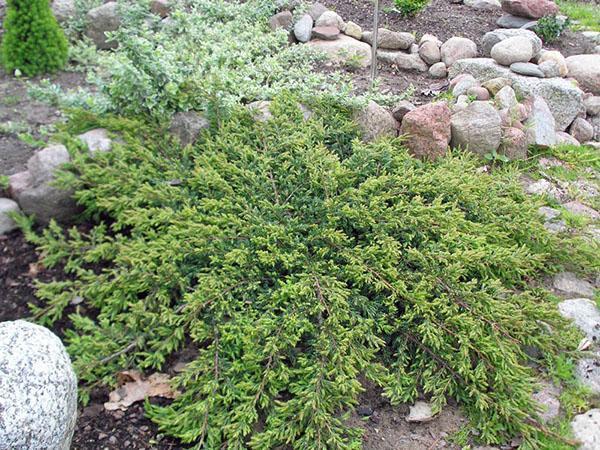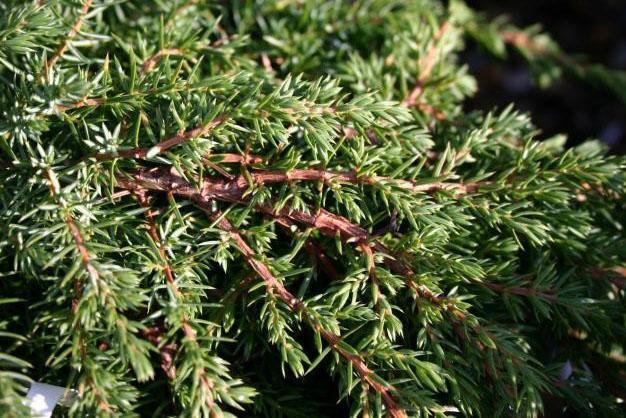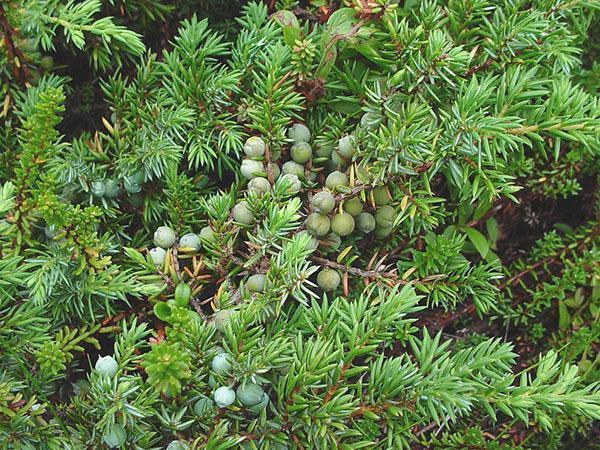Find a place in the landscape design of the site for the Repanda juniper
 Junipers with shoots creeping along the ground form a green living carpet and have long been popular in landscape design. One of these shrubs is the Repanda juniper, undersized, winter-hardy and unpretentious.
Junipers with shoots creeping along the ground form a green living carpet and have long been popular in landscape design. One of these shrubs is the Repanda juniper, undersized, winter-hardy and unpretentious.
The variety was obtained in Ireland, first became available to gardeners in 1934 and still enjoys well-deserved love in all parts of the world.
Description of the juniper Repanda

The crown is formed by thin, densely branching shoots, densely covered with needle-like, up to 5-8 mm long, soft needles. A characteristic feature of the variety is the silvery-white stripes on the outside of the needles. In summer, the needles are green, and in winter, the shrubs turn brownish-green. On adult plants of the common Repand juniper, rounded cones up to a centimeter in size appear. Ripening fruits turn from green to bluish-blue, covered with a thick whitish bloom.
 A juniper of a compact ground cover form with an increase of up to 12 cm in width and about 3 cm in height will be useful:
A juniper of a compact ground cover form with an increase of up to 12 cm in width and about 3 cm in height will be useful:
- on an alpine slide, on the curb, like a tapeworm when decorating a summer cottage;
- despite the polluted air, in the city square;
- as a potted plant on a terrace, balcony or patio.
Juniper variety Repanda, (in the photo juniper), is well tested by time, has excellent winter hardiness, lends itself well to vegetative reproduction, without losing its decorative qualities.
Planting and caring for the Repanda juniper
 Different varieties of common juniper have common features. These include undemanding soil composition.
Different varieties of common juniper have common features. These include undemanding soil composition.
Plants are equally well acclimatized on soil with low acidity and with a weak alkaline reaction. However, according to the description of the Repand juniper, the shrub grows better on loose, moderately moist and nutritious soils.

A mixture for planting is prepared on the basis of sod land, sand and peat with the addition of complex fertilizers for coniferous crops. So that the roots of the juniper are not at risk of decay, drainage from expanded clay and broken brick is poured at the bottom of the planting pit. If the plants are to become part of a wide free-form curb, a gap is left between the shrubs sufficient for the growth and closing of the crowns.
If you choose the right place for planting, caring for the Repanda juniper will be much easier.
 Ephedra photophilous, grows well in partial shade. The best place for junipers is a protected area on the south side with light draining soil and deep groundwater. The shrub can withstand:
Ephedra photophilous, grows well in partial shade. The best place for junipers is a protected area on the south side with light draining soil and deep groundwater. The shrub can withstand:
- frosts down to –29 ° C, so he does not need a special shelter;
- lack of lag in the soil if sufficient air humidity is maintained;
- proximity to any floral and decorative deciduous plants, which makes the variety truly versatile.
 In hot dry weather, the Repanda juniper is watered.The plant accepts well sprinkling, which is carried out in the evening, so that the needles are not at risk of burns.
In hot dry weather, the Repanda juniper is watered.The plant accepts well sprinkling, which is carried out in the evening, so that the needles are not at risk of burns.
Creeping juniper varieties do not need special pruning. Subject to the rules of agricultural technology, the culture independently forms a squat crown of rounded outlines.
 However, in the spring, dead or damaged shoots must be removed. At this time, cuttings are harvested for plant propagation and layering are made, which, after rooting by autumn, will become full-fledged seedlings.
However, in the spring, dead or damaged shoots must be removed. At this time, cuttings are harvested for plant propagation and layering are made, which, after rooting by autumn, will become full-fledged seedlings.
Juniper Repanda in landscape design
 A compact ground cover juniper is an excellent choice if you have to decorate a rock garden, rocky area, garden paths or extensive lawns.
A compact ground cover juniper is an excellent choice if you have to decorate a rock garden, rocky area, garden paths or extensive lawns.  In areas with difficult terrain, growing in breadth plantings will help to strengthen and green the slopes, prevent the growth of ravines and shedding of soil near the stairs.
In areas with difficult terrain, growing in breadth plantings will help to strengthen and green the slopes, prevent the growth of ravines and shedding of soil near the stairs.
In landscape design, the Repanda juniper is also used as a pot culture. Containers with shrubs that are not afraid of heat, cold weather and gas-polluted air form a green island on the balcony, flat roof, on the terrace and near the entrance to the house.



 For planting, it is better to choose plants with a closed root system. They take root better, which is especially important if you have to grow an even green carpet or curb. Such seedlings can be transferred to the ground not only in spring, but also throughout the warm season, they are less sick and immediately begin to grow in a new place.
For planting, it is better to choose plants with a closed root system. They take root better, which is especially important if you have to grow an even green carpet or curb. Such seedlings can be transferred to the ground not only in spring, but also throughout the warm season, they are less sick and immediately begin to grow in a new place.